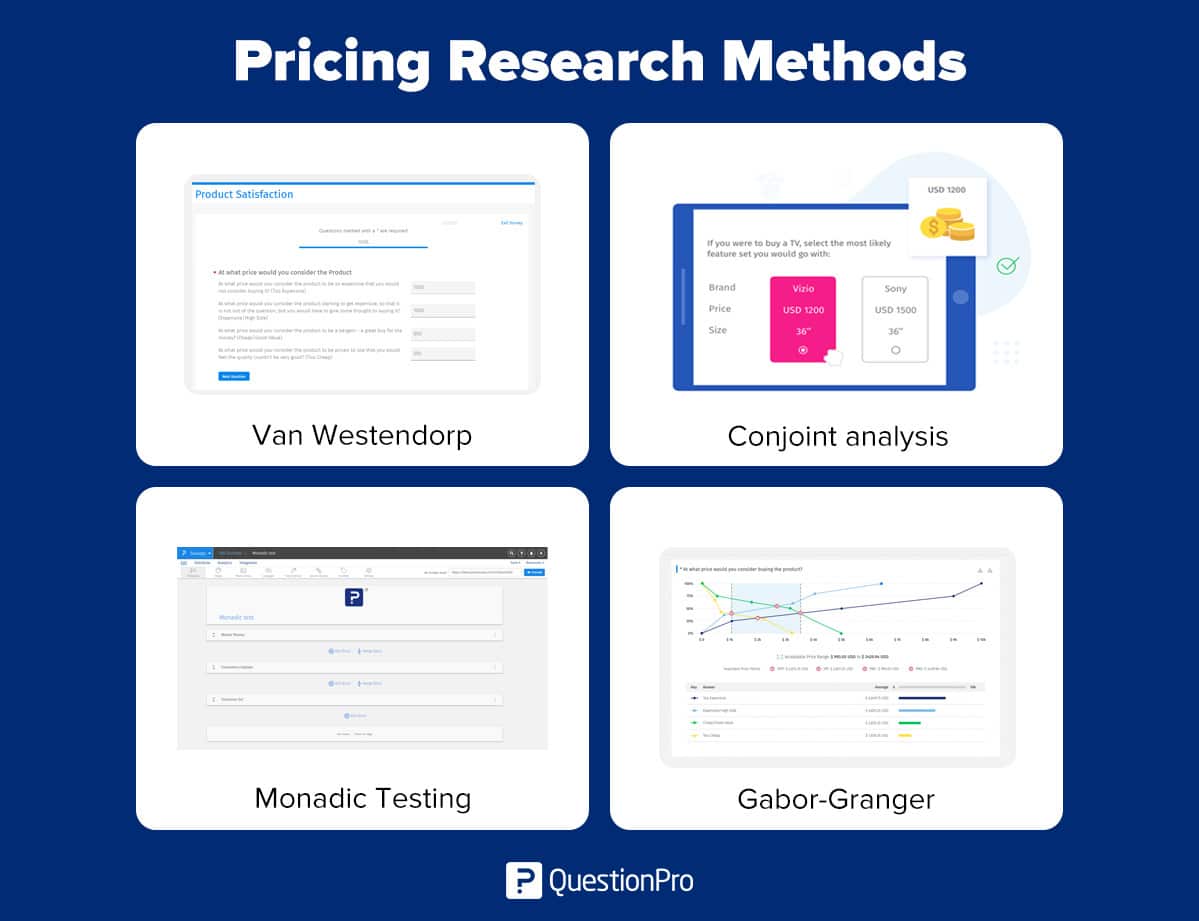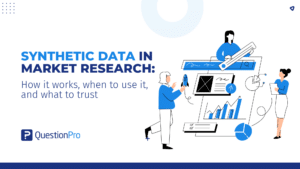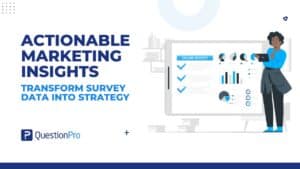
Pricing can make or break a product. Set it too high, and you risk turning customers away. Set it too low, and you may hurt your margins or brand perception. That’s why understanding the types of pricing and how to research them properly is essential for any business. An optimal and effective pricing strategy can significantly increase a company’s revenue, with studies showing variations can raise or lower price revenue by 20-50%.
While there are many pricing strategies out there, this article focuses on four powerful pricing research methods that help you identify the right price based on real customer input: Van Westendorp, Conjoint Analysis, Monadic Testing, and Gabor-Granger.
You’ll learn how each method works, when to use it, and how it contributes to building smarter, more effective different pricing strategies.
What is Pricing Research?
Pricing research is a quantitative method used to determine how much customers are willing to pay for a product or service. It helps businesses identify the optimal price point that balances customer perception of value, market demand, and profitability.
Instead of relying on assumptions or competitor pricing alone, pricing research gathers real data from target customers to evaluate how price affects their purchasing decisions. This includes understanding price sensitivity, perceived value, and the trade-offs customers make between features and cost.
However, fewer than 5% of Fortune 500 companies have functions dedicated to setting the best price possible, highlighting the untapped potential of pricing research.
Pricing research is especially useful when:
- Launching a new product or service.
- Entering a new market.
- Repositioning an existing product.
- Testing different types of pricing strategies.
By conducting pricing research, businesses gain the insights they need to set prices that are competitive, realistic, and profitable, while also aligning with customer expectations. Choosing the best pricing method is often more powerful for growth than customer acquisition, as it directly impacts revenue and profitability.
Types of Pricing Research Methods to Find the Right Price
Choosing the right pricing research method can make the difference between pricing guesswork and confident, data-backed decisions.
Below are the four most widely used and effective pricing research techniques, each with its own strengths depending on your product, stage, and market conditions.

1. Van Westendorp Price Sensitivity Meter: Method for Accurate Pricing
The Van Westendorp Price Sensitivity Meter is a survey-based method that helps determine a product’s acceptable price range and optimal price point based on consumer perception.
How it works:
Respondents are asked four simple but powerful questions:
- At what price would you consider the product to be too expensive to buy?
- At what price would you consider the product to be too cheap, so you would question its quality?
- At what price does the product begin to seem expensive, but still worth considering?
- At what price does the product seem like a bargain, a great deal?
By plotting responses on a graph, you get intersections that define:
- Optimal Price Point (OPP): where the number of people who think the product is too cheap equals those who think it’s too expensive.
- Indifference Price Point (IPP): where the product is seen as neither too cheap nor too expensive.
- Acceptable Price Range: between the “too cheap” and “too expensive” thresholds.
Outputs of the Method:
- A visual representation of perceived price thresholds.
- The range of acceptable prices and the single best price to target.
Pros:
- Easy to understand and implement.
- Highlights psychological pricing boundaries.
- Great for early product development.
Cons:
- Doesn’t capture feature-based trade-offs.
- Lacks real-world behavioral validation.
Best used for:
- New products in development.
- Branding or repositioning exercises.
- Products with flexible competitive pricing potential.
2. Gabor-Granger: Test Customer Willingness to Pay
The Gabor-Granger technique directly tests willingness to pay by presenting customers with a series of increasing price points and asking if they would still buy the product at each level.
How it works:
A respondent is asked:
“Would you purchase this product at $19.99?”
- If the answer is yes, the next price is higher, like, $24.99, $29.99, etc.
- If the answer is no, the next price is lower. This process continues to pinpoint their maximum acceptable price.
Outputs of the Method:
- Demand curve showing purchase intent at different price points.
- Revenue curve for optimal price-to-profit balance.
- Insights into price elasticity.
Pros:
- Straightforward and quantifiable.
- Excellent for estimating demand.
- Can be used to optimize pricing models for volume or revenue.
Cons:
- It can be unrealistic if not paired with a realistic product context.
- Doesn’t consider feature combinations or competitive comparisons.
Best used for:
- Estimating demand elasticity.
- Choosing an optimal price for digital or scalable products.
- Revenue modeling for different pricing tiers.
3. Conjoint Analysis: Understand Feature-Price Trade-offs
Conjoint Analysis is a sophisticated research method that simulates real-world decision-making. It shows customers different combinations of product features and prices, asking them to choose or rank their customer preferences.
How it works:
Respondents are presented with several product configurations that vary by attributes such as price, color, features, and brand. For example:
- Option A: Smartphone with 128GB storage, $699.
- Option B: Smartphone with 256GB storage, $749.
- Option C: Smartphone with 512GB storage, $849.
Each choice helps the business model understand how much value customers place on each attribute, especially price.
Outputs of the Method:
- The relative importance of each attribute (price, brand, features).
- Willingness to pay for upgrades.
- Market share simulations based on feature-price bundles.
Pros:
- Mimics real-world purchase decisions.
- Helps prioritize product features alongside pricing.
- Powerful for market segmentation and product configuration.
Cons:
- Requires more advanced setup and analysis.
- May need larger sample sizes and more respondent time.
Best used for:
- Feature-rich or configurable products.
- SaaS behavioral pricing tiers.
- Subscription services and product bundles.
4. Monadic Price Testing: Simple A/B Pricing Research Method
Monadic price testing is one of the simplest methods. Each respondent is shown only one price for the product and asked if they would buy it at that price.
How it works:
The target audience is split into multiple groups. Each group sees the product at a different price point (like, $9.99, $14.99, $19.99), and then answers questions about their purchase intent. This prevents bias caused by comparing multiple price points and simulates a more realistic buying experience.
Outputs of the Method:
- Purchase likelihood or intent at each specific price.
- Simple graphs showing which price point drives the highest interest.
Pros:
- Quick to deploy and analyze.
- Clean, direct results.
- Easy to communicate findings to stakeholders.
Cons:
- Each respondent gives feedback on only one price point, so you need a larger sample size to test multiple prices.
- Doesn’t account for trade-offs with features or competitors.
Best used for:
- Quick tests for a new product.
- Single-price digital products or services.
- A/B pricing comparisons.
Choosing the right price for your product isn’t guesswork; it’s business strategy. Each method brings unique strengths depending on your product type, market stage, and research goals.
Whether you’re launching something new, adjusting your pricing, or exploring new segments, these tools give you the data you need to strike the perfect balance between value and revenue. Investing in pricing research isn’t just smart, it’s essential.
Real-World Examples of Pricing Research
Understanding pricing in theory is one thing, but seeing how pricing research translates into real-world applications makes its value even clearer. Below are two examples that illustrate how businesses (big and small) can use the right pricing strategy to make smarter decisions.
Example 1: The $1.50 Cookie Shop
At her first job in high school, Esther LaVielle sold cookies at a mall for $1.50 each, along with sodas priced at $1.29. On average, the shop served about 25 customers an hour. That adds up to around $70 per hour before factoring in labor, rent, or ingredient costs.
The question is: was that price sustainable?
In this case, no pricing research had been done. The prices were based on assumptions rather than customer behavior or perceived value. As a result, the shop struggled with profitability and eventually shut down.
Had the owner conducted even a simple Gabor-Granger or Van Westendorp study, they could have tested whether customers were willing to pay $1.99 or $2.49 per cookie without affecting demand, and possibly saved the business.
Lesson: Underpricing may attract customers, but without market research, you risk running at a loss.
Example 2: Why iPhone Users Will Pay $1,000+
Apple is often seen as a masterclass in the best pricing strategy. When launching iPhones at $999 or more, many questioned if customers would actually pay such a high price.
But Apple wasn’t guessing; they understood what their customers valued most: cutting-edge photography, smooth performance, app development capabilities, and a premium ecosystem.
By applying conjoint analysis, Apple could assess how much value customers place on these features relative to price. The result? Confident pricing backed by customer insight.
Lesson: People aren’t just buying a phone, they’re buying into what they care about most. Pricing research helps uncover those key drivers.
How QuestionPro Supports All Types of Pricing Research
Conducting dynamic pricing research is only as good as the tools you use, and that’s where QuestionPro comes in. Whether you’re exploring new markets, launching a product, or fine-tuning your right pricing strategy, QuestionPro gives you the platform to collect, analyze, and act on real customer data.
Here’s how QuestionPro supports the different types of pricing research:
- Van Westendorp: Set up the four-question survey and instantly obtain price curves, OPP, and acceptable price ranges – no manual work required.
- Gabor-Granger: Use logic-based pricing surveys to find the price that maximizes demand and revenue through sequential price testing.
- Conjoint Analysis: Simulate real-world choices and uncover which features and price combinations matter most to your customers.
- Monadic Testing: Show different price points to separate groups and measure purchase intent, ideal for A/B testing and quick evaluations.
Additional Advantages
- Powerful survey logic to personalize and branch based on answers.
- Real-time dashboards to analyze price sensitivity and willingness to pay.
- Integration with panels to reach your ideal target audience.
- Exportable reports and visualizations for internal presentations.
QuestionPro simplifies the complexity of the pricing model so you can focus on making confident, revenue-boosting decisions based on solid data.
Conclusion
Pricing is one of the most important levers you can pull to drive revenue, customer satisfaction, and long-term growth. By using pricing research methods, you can uncover what your customers are truly willing to pay and the reasons behind their decisions.
Each method offers unique insights, from psychological thresholds to trade-off preferences and demand curves. Through the article, we gained an in-depth understanding of the most common types of pricing research methods.
With platforms like QuestionPro, running pricing research becomes easier, faster, and more actionable. You get powerful tools, expert-built templates, and flexible logic all in one place so you can focus on making decisions that move your business forward.
Frequently Asked Questions(FAQs)
Answer: It asks respondents four questions to determine when a product feels too cheap, too expensive, a bargain, or a bit pricey. From this, it calculates an optimal price range and price point.
Answer: Monadic testing shows each respondent only one price point, measuring purchase intent without comparison bias. It’s best for simple A/B testing and small product variations.
Answer: Gabor-Granger is ideal for estimating demand elasticity. It identifies the maximum price customers are willing to pay by gradually increasing or decreasing price points in a survey.
Answer: Van Westendorp and Monadic Testing are often best for early-stage products. Van Westendorp gauges acceptable ranges, while Monadic tests specific price points quickly.
Answer: QuestionPro offers built-in tools for all four methods, including survey templates, conjoint modules, logic branching, and real-time dashboards to analyze price sensitivity and willingness to pay.







